#-but at the very least you have to the pronunciation somewhere in hiragana
Text
// People mispronouncing pho ("fuh"- it's really spelled phở because our accents are confusing and hate you with a passion) does actually give me psychic damage. The noodle soup is not your "foe," it's your "fuh"-riend :(

and that's why this store is the funniest thing I've ever seen
#just pronounce pho correctly and you get ''fuh-king'' which.#ehe#ehehehehehehehe#cw cursing#but actually also....... I personally don't like pho all that much :(#the beef broth is a lil too rich and greasy and I don't like the sweetness :(#chicken pho is better though I like chicken pho :)#also on vietnamese accents I've never had a nonviet person pronounce my last name correctly#it's just a minor annoyance but looking back on it it makes me... kind of sad#people try their hardest though so i can't blame them#i've had my first name said really really incorrectly before though (even though it's traditionally a white name) so maybe people just-#-don't know how to pronounce names haha#i do feel a bit sorry for my bro tho because he has a viet 1st name and no one says it right (or maybe I say it wrong? Hmm...)#suddenly feeling a little envious of japanese names.... you can never really be 100% sure how to pronounce them (unless they're hiragana)-#-but at the very least you have to the pronunciation somewhere in hiragana#mun rambles
56 notes
·
View notes
Text
Japanese notes - lesson 1 (30/5/2022)
The purpose of this writeup is primarily to help cement it in my brain, but I will put it up here in case it’s of interest to other people!
I am studying Japanese with a friend, she’s not a native speaker but has had formal teaching and is a lot further along than I am. For her this is an opportunity to cement the basics and enthuse about languages with someone, and I’m going to repay her in kind through animation work somewhere down the line.
Today the main thing we did (beyond simply chatting about Japanese, what I already know, what the long term goal is) was read the Genki - An Integrated Course in Elementary Japanese textbook. We started right from the beginning and alternated reading out passages, which helped rein in our ADHD habits lol, and my friend gave me detailed feedback on pronunciation and speaking in general, which was incredibly valuable, the thing I’ve been wanting for years.
I went in knowing hiragana pretty well (at least to read, not so much to write) and reading about 60-70% of katakana when I tried a quiz. I need to learn the rest of the katakana asap. (Actually, reading manga and paying attention to the onomatopoeia has been pretty good practice for reading katakana! But it has gaps.) I’m going to practice writing the kana as well. We want to do away with romaji as soon as possible lol.
Here are some things I made a note of during the lesson:
pronouncing らりるれろ - this has been a persistent headache with me but in fact a brief bit of feedback on my friend got me on the right track and i was doing pretty well by the end.
the trick is that your tongue should tap the ‘alveolar ridge’, a hard bit of the roof of the mouth behind the teeth. it feels to me very slightly forward of where it taps in an ‘r’ or ‘l’ sound and importantly, you don’t move your lips nearly as much as you do in English.
pronouncing ふ - this one was interesting because i hadn’t realised it’s actually a bit different from the english ‘f’ sound so it took a lot of tries. the major thing is that the lips don’t meet; i also have a note saying “less plosive”. my friend described it as being something like halfway between the English ‘h’ sound and the English ‘f’ sound.
Edit: just advised this is called the voiceless bilabial fricative!
pronouncing わ and を - Also not exactly like the English ‘w’. Lips don’t move too much. “Don’t move your lips too much” is something of a running theme.
dropping the -u sound - I was aware that in some circumstances, such as です and -ます, you drop the ‘u’ sound, but my friend gave me the actual rule.
The ‘u’ sounds in す and つ and ‘i’ sounds in し and ち can be dropped at the end of words, or in between ‘hard’ consonants which include ‘s’ and ‘k’ sounds such as in 好き suki or 明日 ashita. In these cases you drop the u sound (it becomes unvoiced). apparently this can vary with dialect and doesn’t happen as much in kansai-ben.
pitch accent and cadence - we haven’t started on pitch accent patterns or anything like that yet, but my friend was getting me to try and get the cadence and pitch right when i echoed stuff back to her and i could tell it made a huge difference.
Here’s what I was already aware of: Japanese is not a stress-accent language like English, and you pronounce each mora with generally very regular cadence and stress (though my friend added here that this can actually vary a bit with dialect). However, it does have pitch-accent, so you have pitch that rises or falls at certain points, and this is more important than English stress-accent because words can be homophonic up to pitch accent so getting it wrong will sound weird and confusing. (It’s not a tonal language like Chinese, context is still the main clue to distinguish homophones, but it’s not unimportant either.)
One thing to know it, another to put it into practice. This was quite hard for me to get at first since even when I could hear the pattern, I haven’t learned to sing and I don’t have great pitch control, but I definitely think I was getting the hang of it by the end of the lesson - it was really really helpful being able to just try a word over and over with my friend on the call until I started to get the hang of it. Next time we’re going to watch anime very slowly and echo line by line and I’m looking forward to that a lot.
We talked about saying 私 watashi, something demonstrated in this video by Dogen. Actually my notes seem to be a bit inconsistent with what Dogen says here, so I think I got confused about something, because my notes say it has a falling pitch at the end and that doesn’t seem to be true. Anyway I added a browser extension that adds pitch accent info to jisho.org, so I’ll be able to practice saying things right when I look them up now.
One thing that is interesting is that thinking about pitch accent and cadence, although at first taking a lot of concentration, actually helped me think about speaking in a different way. I was doing decently when I was in that zone, but when I read a Japanese word in the middle of a passage of English text it was like my brain didn’t switch tracks quick enough and I read it in an English style. so that’s kind of cool to see even at this early stage. I can see just why Dogen can go from sounding like a Japanese person to having a very American accent so suddenly.
stroke order - my friend explained there is a general pattern (with exceptions inevitably) to stroke order, so it’s not as brutal as it looks at first.
as i understand it the ‘algorithm’ is something like, you group the strokes into radicals, and then for ordering the radicals overall, and ordering the strokes within a radical, you start from the top left and go left to right, then top to bottom. that still leaves some ambiguity but you’ll learn the specific patterns, e.g. if you’re drawing a box-shaped radical you tend to draw the left vertical, then the top and right sides as one stroke, then the bottom stroke, so if you see a radical like that in a kanji you can usually expect it to go like that.
we watched some amusing videos by NativLang talking about the ridiculous complexity of the Japanese writing system. but like, kids can learn this stuff, adults can learn this stuff, if I put the time in I’ll get there.
aizuchi - as we were approaching the conversation and grammar section, my friend mentioned 相槌 aizuchi, words like なるほど and 本当に (ほんとうに) which you use to show you’re listening in a conversation. I imagine we’ll cover those in detail at some point.
aisatsu - this was the very first part of the vocab section. the book actually had some cute little illustrations for each one:

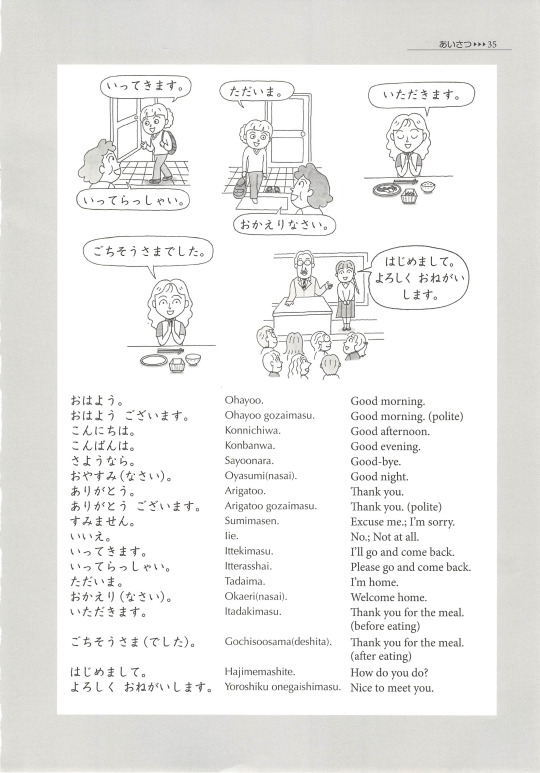
the illustrations are a great way to give meaning to the words without parsing them through English.
a lot of these I was aware of thanks to anime, but a couple likeいってきます/ごちそうさまwere new to me, and of course it was very useful to get help pronouncing them.
a couple that came up which weren’t in the book: if someone thanks you (ありがとう), some of the responses you might give depending on context are:
こちらこそ - essentially, “no, thank you”
なんでもない - “it’s nothing”
I didn’t write this down but I think she said you might even apologise. Perfect language for me I guess ;p
watching anime: We watched a couple of episodes of かげきしょうじょ!! Kageki Shōjo!!, an anime about a fictionalised Takarazuka school. Unlike Revue Starlight it’s a lot more grounded and more overtly alluding to the real Takarazuka Revue (with reference to specific performances like Rose of Versailles, the troupe system, students expected to clean the halls...); the wish to be Top Star is one source of conflict but characters are aspiring to e.g. be otakuyaku and musumeyaku and not merely the Top Star, but also the gender aspect is played up as well with the MC wanting to be in an all-women environment after ordeals with fans during her idol career.
This was just a wind down this week, but I did my best to try to listen to the dialogue and not just read subs. Right now I guess I’m at a stage where I will keep catching random words like “I know that one” but don’t have the grammar knowledge to really fit them together yet. Next week we’re going to watch it back much slower and listen closely to the dialogue.
using Anki: @baeddel showed me how to set up Anki while I was at hers, so the next step for me is to put some version of all this new information in there and see if the magic of Spaced Repetition can pack it into the folds of my brain.
19 notes
·
View notes
Text
Hideyoshi & Polish!MC
Sorry. I had to. Originally, I wanted those to be fluffy - but it’s so silly now and there’s no going back, I’m so sorry Hideyoshi, you just have to deal with a bratty person. Chaotic energy unleashed. Somewhat chaotic at least. No general plot, just a couple of situations.
It is in no way representative of each and every person. Tbh, I kinda collected the more fun, maybe somewhat stereotypical traits and put them in a combination that would most probably torment Hideyoshi.
Content Warnings: alcohol
Hideyoshi
Had it not been for Nobunaga’s interference, she’d surely be thrown into the dungeon. She was put under Hideyoshi’s watch instead, most probably just to poke fun at him, as... Well, he didn’t understand a single word she said - and she didn’t seem to speak Japanese.
Not everything can be explained with simple gestures after all, at least not without binding them by laws of a language. How was he even supposed to tell her that the women who surrounded him in the market weren’t exactly his lovers? He could just watch her standing somewhere in the background, giving him a condescending look.
Did she work at the castle? Yes, but he couldn’t offer her any help or word of advice, even despite the fact he wanted to - and truth be told, he felt a strong urge to correct her a whole lot. Firstly, wherever she came from, she was not accustomed to anything regarding their everyday lives - clothes, chopsticks, the way the buildings were build and how to navigate them, everything. If he could, he’d treat her like a clumsy little child.
Powerless, he appointed Mitsunari to teach her Japanese, or at the very least try to.
It started with her picking up the basic vocabulary - point, say the name, hear the name. At some point, Hideyoshi was sure she was making it all up - “źdźbło trawy”? Luckily, she progressed to writing rather fast, the hiragana being essential.
One day, she was practising writing, when she spilled the ink over the tatami mats. Hideyoshi had just entered the room and heard her groan:
“ Kurwa.”
“ Kul-ła?” he repeated, making her aware of his presence.
She instantly looked up at him, her face growing red. To witness your mother swearing is a one thing, it is another if it’s your grandmother - but if they say it the way a child, that had just barely started wrapping its head around the rules of pronunciation would, it’s something else entirely.
“ What is it?”
“ Bad word, bad word,” she exclaimed, crossing her arms in front of her chest. “ Bad Hideyoshi, no no no.”
He didn’t know what she meant. It was better like that.
She did learn to speak Japanese eventually. However, if she got drunk, she switched back to her native language. Hideyoshi didn’t know what kind of drunk she was, except of course, the most entertaining one - at least according to Nobunaga.
“W dupieś był, gównoś widział.”
She kept apologizing to him for the next couple of days. He didn’t know what she meant. It was better like that.
Her attitude was often driving him insane. “Wykombinuje się coś.” - always. It would always do just that. What it meant? He didn’t know. Again, it was for the better.
Luckily, Hideyoshi didn’t know what phrase “Miłość i sraczka przychodzi znienacka” meant either. Otherwise he wouldn’t be so happy about Mitsunari repeating it.
However, she taught him one phrase. It was “Im mniej wiesz, tym spokojniej śpisz”. He lived by that notion.
Please, give this mum a break, he is not ready for the mayhem of Polish “fun” stuff. I’m low-key sure MC would sing discopolo songs for him as well (I am NOT torturing myself, just him. If you’re curious, dunno, search “Palą się ropczyce” on YT or “Majteczki w kropeczki”. You are safe from the lyrics, I am not. I’m so sorry).
Dictionary:
źdźbło trawy - a blade of grass,
kurwa - a profanity, literally: a derogatory term for a prostitute; you... Don’t really want your mother hear you use that, at least I think so. However, it’s being overused and seems to be slowly losing its shocking effect. Some people use it as a comma - and that’s basically a stereotype of a dumb person.
“Kul-ła” (I suppose kul - wa would be more appropriate in English) - how I’d phonetically spell the way he would most probably pronounce it. You know, like a child.
“W dupieś był, gównoś widział” - “You were in the ass, you saw shit”, also: “w dupie byłeś, gówno widziałeś”; usage: it can be said to somebody who is speaking on a matter they have no idea about, yet portray themselves to know a whole lot on the topic. Basically, a snarky, maybe a bit crude way of telling them “you know nothing”.
“ Wykombinuje się coś “ - “It will figure itself out”; I guess it’s a common mentality trait of some people? You know, you may play at the border of laws, take some really directly, be a bit creative, but in the end, it will be good, as you will wykombinować something.
“Miłość i sraczka przychodzi znienacka” - “Love and diarrhea come at the least expected time”; I have love-hate relationship with this saying. I hate when others use it, but in and of itself, it’s crudely hilarious. (I’m starting to think there are many more saying with shit, butts and what not than I was initially aware of).
“Im mniej wiesz, tym spokojniej śpisz” - “The less you know, the better you sleep.” ; Ironically, that’s the phrase I forgot to translate - now it’s the edit.
I will not direct you to any of discopolo songs. Just be aware that’s what plays during the wedding reception, or wesele. You know, the huge party, with dancing and alcohol. Yes, a song about polka-dot panties may play on stereotypical Polish wedding reception. I hate them. I’m no fun.
The last ones were more serious, this time... Save me.
Tag list: @datenoriko , @nad-zeta , @tsubaki3192 , @choi-jiyu
If you want to be tagged under my future works, let me know (any way works)!^^ Also, if you have some preferences (for example: you’d rather not be tagged under some series, etc.), please, tell me.
#hideyoshi toyotomi#ikesen hideyoshi#ikemen sengoku hideyoshi#ikemen sengoku#ikesen#ikemen series#please dont hate me#odpokutuję to później
99 notes
·
View notes
Text
the swallow’s compass;
Here are translations of various Hingan signs, both within Kugane and The Swallow’s Compass.
...That’s the simple explanation, anyway. The full post below involved a lot more research than I expected, but I don’t really know how else I should describe what I’m doing here. I imagine that this will be fairly interesting to those loremongers with a special interest in Doma and Hingan culture, so if you really like Kugane, or you write a Doman character or something, come on in!
...That said, now I have no idea where I should begin.
I guess I’ll start from the top. I’m not sure if this is widely-known information within the “Western” FFXIV fandom, so forgive me if I’m parroting things that you already know, but basically, the the signage in Kugane and Doma utilizes a “Hingan alphabet” that is essentially a substitution cipher for Japanese hiragana. You know how Eorzean works, right? With the Eorzean signage in the game, the letters of the Eorzean alphabet are substitutes for English letters... so with Doman signage, the characters in the Hingan alphabet are substitutes for Japanese characters.
If you can read hiragana, you can check it out yourself at this fansite here.
I should note that the Japanese version of FFXIV doesn’t really utilize the concepts of “Doman” and “Hingan” the way that the English version does, so Japanese fans refer to the “Hingan alphabet” as クガネ文字、 or “Kugane characters.” I should also note that it seems straightforward enough until you realize that a lot of the in-game signage is highly stylized, so reading it is a lot harder than you’d think, sometimes...

Let’s take a look at the sign outside the Shiokaze Hostelry, shall we?
Broken down — and reading vertically from right to left, of course — the characters here read:
youkoso
Kugane e
Welcome to Kugane.

Here’s another example: the banners in the Sekiseigumi Barracks! What do they say? Well... they’re not very interesting, actually. This just says:
Kugane Sekiseigumi
At least they’re proud of themselves...
I considered photographing and documenting every instance of Hingan writing that I could find, but the fact of the matter is, a lot of it is very self-explanatory: the sign outside of the Bokairo Inn, for example, just says Boukaisen, advertising the Bokaisen Hot Springs. (By the way, I believe the localization team chose to go with short-vowel romanizations to encourage correct pronunciations among non-Japanese players, so that’s why there’s an extra vowel there.) So it wouldn’t have been very interesting for me to go around taking pictures of every single sign I could find...
One thing in Kugane I do find really interesting, however, is the sign just outside of the Mujikoza theater!

This sign is actually an advertisement for the actors at Mujikoza:
enja
(”Performers”)
Maibito Shiranami
Narita Rakuyou
Gakunin Fuuran
Gakunin Yabusame
Narita Ransetsu
Narita Yachiyo
Maibito Kikusui
I am not sure if these are intended to be surnames or titles. My assumption is that they are titles, because Gakunin is probably 楽人、or musician, whereas Maibito probably means 舞人 、or dancer. Unfortunately, I can’t figure out what “Narita” means in this context, because it definitely isn’t the airport. My guess is that it might be a yagou — a stage name, or acting-house name, which you can read about here.
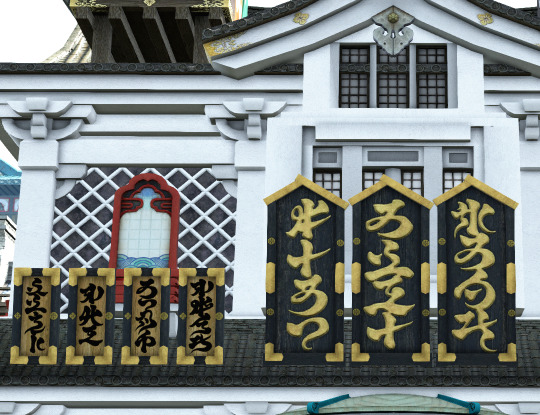
Note that the actors again receive top billing on the roof of the building, where the sign reads:
SHIRANAMI
RAKUYOU
FUURAN
Yabusame
Ransetsu
Yachiyo
Kikusui
Shiranami, Rakuyou, and Fuuran must be really popular?!
I’ve got one more surprise from Kugane to show you all, but before we get to that, let’s dive into the Hingan text in The Swallow’s Compass.
First, a little background information: The Swallow’s Compass is, in Japanese, called 風水霊殿 ガンエン廟 — very literally, “feng shui temple, gan-en mausoleum,” but since the localization has decided to translate feng shui as geomancy, I think the Japanese dungeon title is best rendered “The Palace of Geomancy: Ganen’s Tomb.”
The English description of the dungeon elaborates on this somewhat:
Enshrined within this tomb, his likeness carved on an imposing scale into the cliffside, is the person of Ganen, the great general who united the warring clans of Yanxia to arise as the first king of Doma. A skilled swordsman and mage both, he is credited as the founding father of Doman geomancy.
Anyway, with that background knowledge, let’s dive right into the signage in The Swallow’s Compass. Quite a lot of it is, um, pretty cool, but really very redundant in my opinion — you know, it’s a million different lines about earth and wind and water — so I have to admit I’m glazing over some of it...
Just imagine a lot of stuff like this...
hagukumutsuchi
soil nurtures
megurumizu
water circulates
hakobukaze
wind carries

Notably, this tablet just past the first boss is a quote attributed to Ganen himself:
kaze wo shirite
mizu wo seishi
chi wo osamuru
ganen-ou
Know the wind
Contain the water
Heal the earth
— King Ganen
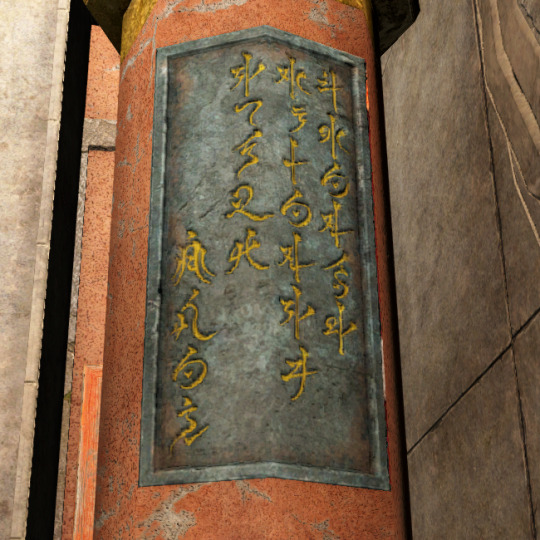
The tablet to the right of King Ganen’s reads as follows:
mu ni naru kawa
ryu ni naru yama
yansa no chi
doma to nasu
As the river turns to nothing
And the mountain becomes a dragon
Does the land of Yanxia
Form the nation of Doma
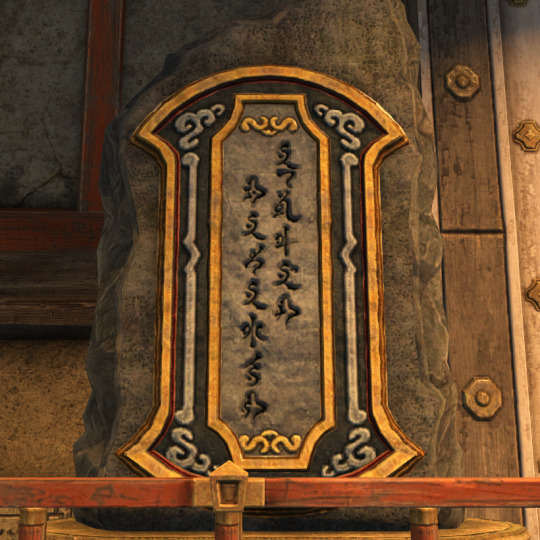
Lastly — I have not included screenshots of every single stone, because it would just be too many pictures that all basically look the same — two famous Chinese poems are quoted throughout the dungeon! I won’t get into the whole history of kanshi poetry and the tradition of Chinese poetry in Japanese literature, but suffice it to say it’s a personal favorite subject of mine.
The Swallow’s Compass quotes two lines from “In the Mountains on a Summer Day” by Li Bai, for which I have enclosed two translations (not by me, of course):
夏日山中
李白
懒摇白羽扇
裸袒青林中
脱巾挂石壁
露顶洒松风
In the Mountains on a Summer Day, by Li Bai
trans. Arthur Waley, 1919
Gently I stir a white feather fan,
With open shirt sitting in a green wood.
I take off my cap and hang it on a jutting stone;
A wind from the pine-trees trickles on my bare head.
A Summer Day in the Mountains, by Li Bai
trans. Andrew W.F. Wong, 2014
Too lazy to wave my fan of white plumes;
Rather, go naked, ‘neath the greenwood trees,
My headcloth undone, on a stone wall hung,
Idling, bare-headed, in the pine-filled breeze.
Peresonally, I think Wong’s translation is better by far, and more ambitious with the rhyme scheme and structure, but Waley’s is more well-known, as you might imagine. Oh, and I’ve italicized the lines that are quoted in FFXIV! The rest of the poem isn’t in the dungeon, but it seems silly to only enclose a part of it here.
The Swallow’s Compass also quotes another poem by the master of masters, Du Fu. There are many translations of Du Fu’s “Spring Prospect,” but here’s one that I liked:
春望
杜甫
国破山河在
城春草木深
感时花溅泪
恨别鸟惊心
烽火连三月
家书抵万金
白头搔更短
浑欲不胜簪
Spring Prospect, by Du Fu
trans. John Tarrant, 2014
The nation is broken –
mountains and rivers remain.
Spring comes to the city
overgrown with grass and trees.
Feeling the time –
flowers weep,
hating captivity –
bird calls pierce the heart.
The war beacons have burned
for three months now
and I’d give ten thousand pieces of gold
for a letter from home.
I’ve torn my white hair
till it’s so thin
it almost won’t
hold a hatpin.
With these poems in mind, I’m coming back to the final sign from Kugane that I saved for last...

The wall scroll in Hancock’s office reads:
saihi akatsuki ni izureba
shimoyuki no gotoshi
This, too, is a quote from a kanshi poem, but this poet isn’t very well known at all. Instead of another big-name poet like Li Bai or Du Fu, someone on the dev team decided to quote “Keirinsou Zatsuei” by Hirose Tansou — a really very obscure poet better known for being an egalitarian educator.
...Since no English translation of this particular poem existed, I decided to translate it myself. This involved a lot of personal research and time, so I wound up translating a small selection of Hirose’s poetry as the final project for one of my translation classes. I considered submitting my collection of Hirose’s poetry for publication somewhere, but in the end, well... I don’t know, I mean, who would care except for FFXIV players?
The poem itself is a celebration of friendships forged during one’s schooling years. I have enclosed a direct translation and a more structured, syllabic, rhyming translation:
桂林荘雑詠
広瀬淡窓
幾人負笈自西東
両筑双肥前後豊
花影満簾春昼永
書声断続響房書
休道他郷多苦辛
同袍有友自相親
柴扉暁出霜如雪
君汲川流我拾薪
遙思白髪倚門情
宦学三年業未成
一夜秋風揺老樹
孤窓欹枕客心驚
長鋏帰来故国春
時時務払簡編塵
君看白首無名者
曾是談経奪席人
Song of the Cinnamon Grove, by Hirose Tansou
trans. haillenarte, 2018
(direct translation)
From east and west we travel, carrying our book-boxes,
through the plains of Ryōchiku — as fertile and lush as ever.
The shadows of the flowers shield us from the sun
as intermittent voices rebound and resonate in clusters of sound.
We shall not rest in foreign lands with bitter feelings in our hearts
when our brothers here, our comrades-in-arms, will soon become our dearest friends.
As we leave the house at dawn, beneath the hoarfrost so like snow,
you will draw our water, and I will collect our firewood.
Distantly, I think of gray hair, and my heart presses against the gates —
my third year at civil service school, and my work isn’t finished.
In the evening, an autumn breeze shakes the ancient trees,
and I rise from my solitary pillow, trembling with wanderlust.
And at last, the sweet return, the glorious springtime of our homelands!
The time has passed, our work is cleared, and our books are layered in dust.
With your hair grown white, you would be nameless to me
but for the hours we have passed debating the sutras, side by side.
Song of the Cinnamon Grove, by Hirose Tansou
trans. haillenarte, 2018
(structured translation, departs from original)
From east and west, we walk with burdens through the fields of Ryōchiku.
The shadows of the flowers shade us as I talk and walk with you.
We shall not rest in foreign lands with bitter feelings in our hearts
when we have friends to stand beside us in our study of the arts.
And as we leave the house at dawn ‘neath frozen dew that looks like snow
‘tis you for whom I tend the fire, you for whom I make it glow.
As I recall the greying hairs my mother and my father wear,
I long to travel to my home, where perhaps I will see them there.
Beyond these years of solemn schooling, I have work that must be done,
but I rise from my lonely pillow, thinking of the rising sun.
And after all of this is over, someday we will return home
with dusty books and whiter hair and fewer, fewer lands to roam;
And you would have no name to me but for the time we spent in class,
Arguing over the sutras, laughing as we lay in grass.
Why do I think the dev team decided to quote this particular poem? Well... read it to yourself. Doesn’t it remind you of a certain scene, from a certain patch, from another expansion, long, long ago...?
368 notes
·
View notes
Text
14 most widespread and popular languages of the world
Few people know that in the modern world there are from 3 to 7 thousand languages. Many of them are considered endangered, since the number of native speakers of these languages is getting smaller every day. Other languages are spoken by hundreds of millions of people and millions more study them as foreign. Language is the main way people communicate and in this article the most popular, widespread and popular languages of the peoples of the world are presented.
14 French
French.
Although this language is not among the ten most widely spoken languages in the world, in our small presentation it takes an honorable 14th place, opening our rating. The French language, in addition to being one of the most widely spoken, is also one of the most beautiful languages in the world, which is often called the language of love, just like the capital of France, the city of Paris is called the city of love. This language is part of the Romance group of languages, has the status of an official language in 29 countries, in particular in Canada, Switzerland, Belgium, Monaco and, of course, France. It is one of the six official languages of the UN and is distributed in a number of African countries, former French colonies. According to some reports, about 250 million people around the world speak French, but it is native to 75 million.
Many people learn French because of its beauty, others learn it because it is a popular language in Europe and knowledge of such a language will be useful for work and travel. This language is not very difficult to learn as a foreign language. Of course, for some people the French language will be easier, for someone more difficult, but many agree that it is somewhere between German and Spanish because of the complexity of the study.
13 Korean
Korean.
Korean is the mother tongue of approximately 78 million people, is the official language of South Korea and the DPRK, and is partially spoken in China, Japan, the United States, and Russia. This language is not very popular and not many people study it in other countries. However, in terms of the number of native speakers, it occupies an honorable 13th place in our ranking of the most common languages on earth. Most researchers attribute it to isolated languages, that is, to languages that do not belong to any known language family. However, some believe that the Korean language may be part of a hypothetical Altai family. According to some linguists, the Korean language may have some degree of kinship with the Japanese language.
Some find Korean to be easier to learn than Japanese and Chinese, but the grammar, in their opinion, is still more complicated in Korean. Chinese and Japanese are studied mainly for romantic reasons, because of a desire to get closer to the culture of the east and to learn the centuries-old history of the region. Korean is taught mainly for money.
12 German
German.
German is the most popular and demanded language in Europe after English and many learn it not for cultural reasons or for traveling, but specifically for doing business and business negotiations. German is the official language in Germany, Austria, Switzerland, Luxembourg, Liechtenstein and Belgium. This language is native to 100 million people, and its speakers, there are more than 120 million. German is part of the Germanic group, as is English, but German is considered much more difficult than English, like some other languages.
Those who begin to learn a language are scared by words that are 2-3 times longer than their counterparts in other languages, many tenses, conjugating regular and irregular verbs in different ways, the presence of a definite and indefinite article, and not always matching nouns. Nevertheless, the German language cannot be called one of the most difficult languages of the peoples of the world, since with the proper approach it is studied without any problems, like any other European language.
11 javanese
Javanese.
How many languages in the world, but not many of our citizens, in principle, know about the existence of this language, not to mention the fact that the Javanese language is among the most common. This language is spoken by about 105 million people and is spoken mainly on the Indonesian island of Java and several neighboring islands. This is the largest number of speakers of the Austronesian language. This is a fairly developed language, which has a rich literary tradition with different genres of poetry and prose, many varieties of theatrical genres. Despite the fact that almost half of the population of Indonesia actively uses Javanese in everyday life, it, like all other existing languages in the country, does not have an official status. 10 Punjabi
Punjabi language.
This language belongs to the Indo-Aryan languages of the Indo-European language family and is one of the official languages of India. Punjabi is the language of the Punjabis and Jats, ethnic groups in India. The language is common in eastern Pakistan, as well as in parts of India. There are about 112 million people who speak Punjabi in the world. About 105 million native speakers live in Pakistan and India. While the rest lives in countries such as the United Kingdom, Canada, the United Arab Emirates, the United States and others. Among the features of the language, it can be distinguished that it is a tonal language. In tonal languages, the height of the stressed syllable changes its meaning. In punjabi, the stressed syllable can have three different tonal heights. For Indo-European languages, this is very unusual.9 Japanese
Japanese language.
The ninth place in our list of the most widespread and popular languages in the world is occupied by another language from Asia. Native speakers of this language are 130 million people. Japanese is studied mainly for two reasons. Firstly, the language is studied for doing business, since Japan is one of the strongest economies in the world. Secondly, Japan has a rich and interesting culture that attracts thousands of people and sooner or later makes them interested in the language of the country. Japanese can not be called an easy language. One of the main difficulties in learning this language is the hieroglyphs that came from Chinese, but have changed a bit over time in the process of language development.In Japanese, almost all hieroglyphs have not one, but two or more sounds, depending on what words they are used in. Today in Japan, about two and a half thousand hieroglyphs are the most common, while in China at least 3 and a half thousand hieroglyphs are used. Japanese is simpler when compared with Korean and Chinese, but the grammar of Japanese is very complex. There are no tones in Japanese, but there are two alphabets. The Hiragana alphabet is the main one, it is used for purely Japanese words, grammar markings, and ending sentences. Katakana is another Japanese alphabet, it is used for words of foreign origin and names.8 Russian
Russian language.
Russia is one of the most important countries in the world, occupying a vast territory on which many peoples live. The rich, vibrant and rich culture and the most beautiful cities of the country attracts many foreigners who are also interested in the “mighty” Russian language. There are about 160 million people for whom the Russian language is native. In total, there are about 260 million speakers of Russian. The Russian language is official in Russia, Belarus, Kazakhstan, Kyrgyzstan and Tajikistan. This is the most common Slavic language in the world and the most common language in Europe in the number of speakers for whom it is native. Russian is one of the UN working languages. It is rather difficult to study, its grammar is complex, but logical. Russian can be called one of the simple “complex” languages.Many foreigners choose French or German because they are common in Europe. Russian is chosen when they want to learn Russian culture, when there are Russian friends with whom you want to speak their language, when you move to live or work in Russia. Basically, they learn Russian because they like it, like, in general, any other language. You can’t learn a language through power, it should interest and attract, there should be a desire to learn it.7 Bengali
Bengali.
The language of the Bengalis, one of the languages of the Indo-Aryan branch of the Indo-European language family. Spoken and official language in Bangladesh and India. There are about 190 million people for whom it is their native language and about 260 million people who speak it. Some aspects of the language are often different in India and Bangladesh. Writing in most cases is fully consistent with pronunciation. The written language is based on Sanskrit and does not always take into account changes and fusions of sounds that have occurred in the language over time. The history of the Bengali language is estimated at least a millennium, as evidenced by both the dating of the first literary monuments and the data of linguistic reconstruction.6 Portuguese
Portuguese.
Portuguese is the mother tongue of approximately 230 million people, and the total number of speakers is approximately 260 million. It is an official language in Portugal, Brazil, Angola and some other countries. Most native speakers live in Brazil. The Portuguese language in terms of complexity of study is comparable with Spanish, French and Italian, since it is in the same group of Romance languages with them. There are two main variants of the language, European Portuguese and Brazilian, as well as a number of varieties in Africa and Asia, which differ from each other at the level of phonetics, vocabulary, spelling and grammar. 5 arabic
Arabic language.
Arabic is spoken in 60 countries, such as Algeria, Bahrain, Egypt and Libya, and in 26 of them it is official. One of the working languages of the UN and belongs to the Semitic branch of the Afrasian language family. The number of native speakers exceeds 245 million people, and the total number of people speaking it is more than 350 million. Arabic plays an important role in the political and economic spheres, in the field of energy and security. This is a very popular language and people who know it can always find a good job. Arabic is one of the five most complex languages in the world, there are many dialects of Arabic that are significantly different from each other.4 hindi
Hindi language.
This language is one of the 23 official languages of India, and is also distributed in Pakistan and Fiji. The native language is for 260 million people, and the total number of Hindi speakers is approximately 400 million people. At a colloquial level, Hindi is practically indistinguishable from another official language of India, Urdu. The latter is distinguished by a large number of Arabic and Persian borrowings, as well as the fact that it uses the Arabic alphabet, while the traditional Hindi script is the syllabic alphabet of Devanagari. English is one of the official languages of India, but, nevertheless, according to some sources, Hindi is quite a promising language and it may become one of the most popular languages by 2050.3 English
English language.
Three of our list of the most popular and common languages is opened by the English language, which is the most common language for learning as a foreign language. This language is native to 350 million people, and the total number of speakers is about 1.4 billion people. English is one of the UN working languages, the official language of Australia, New Zealand, USA, England, Canada and some other countries. English in the modern world plays a huge role in many areas of life from politics and business, to culture and travel. This is due to the colonial policies of the British Empire in the 19th century and the current global influence of the United States of America.English is also considered one of the easiest languages to learn, if not the easiest. Nevertheless, this language has its own difficulties. In many countries of the world, English is taught in schools from almost primary school as a foreign language.2 spanish
Spanish language.
In second place is a very beautiful language, which is official in Spain, Mexico, Costa Rica, Cuba and most countries of South America. Spanish is very similar to Italian and Portuguese, as it is in the same romance group with them. Spanish is spoken by approximately 420 million people, and around 500 million people speak it all over the world. This is the most common language of the Romanesque group, 9/10 of whose speakers live mainly in the western hemisphere. This is a fairly easy language to learn, which in addition to the Spanish culture and the beauty of the language adds a desire to foreigners to learn Spanish.There are several dialects of the Spanish language, however, Castilian is considered the real, original Spanish language. Castilian, Catalan, Basque, and Galician dialects are common in Spain, while in South America there are five main groups of dialects. The first group is used mainly in Cuba, in the Dominican Republic, Puerto Rico, Panama, Colombia, Nicaragua, Venezuela and Mexico. The second in Peru, Chile and Ecuador. Third in Guatemala, El Salvador, Honduras, Nicaragua, Costa Rica and Panama. The fourth group is the Argentine-Uruguayan-Paraguayan variant, which includes East Bolivia. The fifth group is conditionally called the Latin Hispanic Mountain. This language is spoken by the inhabitants of Mexico, Guatemala, Costa Rica, belonging to the Andes of Colombia and Venezuela, Quito (located at an altitude of 2800 m in the capital of Ecuador), the Peruvian mountain range and Bolivia.1 Chinese
Chinese.
The Chinese language is a combination of very different dialects, and therefore is considered by most linguists as an independent linguistic branch, consisting of separate, albeit related, linguistic and dialect groups. In fact, Chinese is made up of many other languages. But at the same time, the characters are one. Writing the main characters from the middle of the 20th century, after the reform in China, has become much simpler. The unified Chinese language is called Mandarin or just Mandarin, which in China is called Putonghua. In Chinese, there are 10 dialect groups and seven major traditional dialects.
0 notes
Text
June 17, 2018: Let’s Talk About Japanese Toilets
こんにちは、
Japan is a country that really needs no introduction - everyone had been exposed to its culture, its language, and its food at some point; and with Tokyo being a hub for expatriates and tourists, there should not be a huge culture shock to a Westerner visiting Tokyo.
Part of that claim is true, Japanese entertainment accurately showcases the country's daily practices and people generally have a basic knowledge of Japan's differences anyway. Most of the culture shock I experienced were not really culture shock, per say. I knew about these differences, but seeing them in reality and having to perform them really require skills in adaptability.
What was hilarious when landing in Japan was my brain was still thinking I was in China, so whenever I interacted with someone, I accidentally greeted and thanked them in Chinese. It took a few interactions for my head to realize that we were not in China anymore and I can forget words like shui (水) and start remembering words like mizu (水) when asking for water in a restaurant. Sumimasen! Mizu-o kudasai (すみません!水をください!)
I did not miss the hot water China always served me at all. I'm never taking ice for granted ever again.
Before arriving to Tokyo, I really needed to review my kana, two of the Japanese writing systems that include hiragana and katakana. Both hiragana and katakana are the same 104 syllabic sounds, yet they are two completely different systems with different uses. Hiragana is the authentic Japanese writing system that's the basis of all Japanese words, grammar, and pronunciation. Those characters are the ones used when a Japanese writes konnichiwa (こんいちは) or sayonara (さようなら) - they're the Japanese that everybody is exposed with.
Then you have the good 'ole katakana, which is only used when the Japanese write foreign words. As a tourist, this is the writing system you'll see most often in subway stations and airports since the Japanese use words like elevator (エレベーター/erubeta), escalator (エスカレーター/esukareta), and toilet (トイレ/toire).
So, I basically had less than enough time to review 208 total characters from both hiragana and katakana. How exciting!
It was a good idea to visit Japan after spending a few weeks in China because it exposed me to kanji (Chinese characters in Japanese) on a daily basis.
Side note: Japanese uses four different writing systems: hiragana (native Japanese characters), katakana (used only for foreign words), kanji (the Chinese characters used in almost every single word), and romaji (the 26 Roman alphabet letters to write words like Tokyo and konnichiwa). It's important to be familiar at least with hiragana when visiting Japan, because even though you can't read the Chinese characters, there is usually furigana, the Japanese reading aid consisting of hiragana written above or under the characters to show how it's pronounced.
Nobody impresses me more than the Japanese, if you ask me.
The picture shows the three Japanese systems, without romaji. Notice the Chinese characters (kanji) and hiragana? The katakana is written above "Nose breath" which is written to spell "nose breather" (noju buriju).
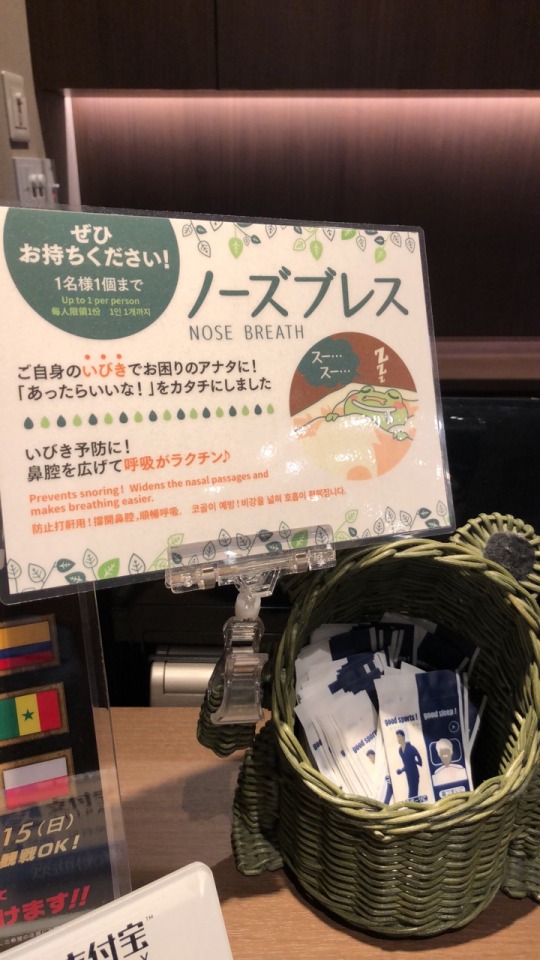
I read an article a while back about how the Japanese subway system had to release an apology because one of the subways left 30 seconds earlier than usual during rush hour, which caused many people to miss the train. Someone from Los Angeles would be lucky if the Silver Line even showed up at all during Monday rush hour.
Naturally, everybody talked to me about Tokyo's extensive subway system before heading off:
"Transportation is never going to be a problem", "Everything is so accessible", "You will never be late".
And it surprised me how accurate these were.
Google Maps claimed that our train from Narita International Airport to the subway stop by our hotel will take 77 minutes. If you know how Google Maps work in Los Angeles, 77 minutes can roughly be translated to either 43 minutes or 128 minutes depending on who was operating the subway that day.
Not in Japan. 77 minutes mean 77 minutes - to the very minute. If the subway arrived earlier, which was rare during my experience, it waits to leave at the exact minute on the timetable so it reaches its next destination promptly.
This was a culture shock I thoroughly enjoyed adapting to.
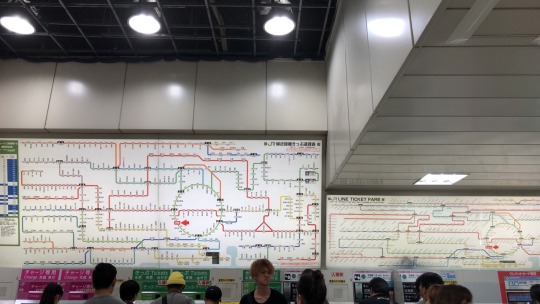
Before leaving for the trip, I was recently made aware of Tokyo's culture on sending their kids to school via the subway system. The city values independence more than anything, since independence is equated with maturity. Children as young as five and six years old were navigating through Tokyo's extensive subway system on their own, which is looked down upon in Los Angeles.
Car culture is huge in Los Angeles - everybody pretty much drives a car, even going to a store that can be reached by a five-minute stroll. There is a hidden stigma, I should say, to those who use the subway system in Los Angeles. It is not an overt judgment, but it is there. Nobody likes to take the subway system in Los Angeles because they're equated to dirty and dangerous. So, imagine how an Angeleno would react finding out that Japan sends their children to school through the subways - the questions and concerns would be never-ending.
The Feed released a video about it if you're interested as to why Japan does this: Japan's Independent Kids
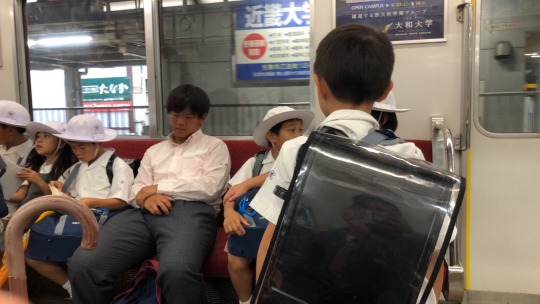
I also wanted a section devoted to comparing and contrasting the toilet culture between China and Japan, because, wow, the change was dramatic.
We just came from a country which was plagued with squatting toilets and urinals that were basically just holes on the ground - even in mega-cities like Beijing. I avoided using every restroom that did not offer a western-style toilet until I find one (or I hold it in until I come back to the comfort of my western toilet in my hotel).
Then there's Japan, where the toilet opens up, prepares the seat protector sheet, warms up the seat, and then greets you. The toilets also have the option to play music for you or offer some background noises for privacy.
Unlike China's squatting toilet and lack of tissue paper everywhere, Japan's toilet culture offered many ways to rinse you off after finishing: sideways, front side, backside, in oscillating motion, and pressurized. You did not need any tissue paper when the toilet offers you a bidet.
I can't believe I'm uploading pictures of toilets, but here are the options you see in most toilets in Japan - and if you're lucky, you might come across an English one!


Most of my knowledge in modern-day Tokyo comes from Vox videos. So, here's one I also recently learned through them - the vending machine culture: Why Japan Has So Many Vending Machines
They're more ubiquitous than the fast food restaurants in America. Tobacco, drinks, ice cream, snacks, frozen healthy goods, condoms, you name it and Japan will have a vending machine dedicated for it. They were my lifesavers, especially when we do a full-day treks in the city and the water bottles in 7/11 were too expensive or the closest Family Mart was a block away. The vending machines were always within reach - and the good news was, they have ¥100-only vending machines. Which means that every single item only cost me $1 USD - insane!
I lived off vending machines during my stay in Tokyo, if you haven't concluded yet.

And the biggest culture shock of them all - one that I planned for us to experience and live through - Japan's signature capsule hotels.
Capsule hotels are regular hotels, but instead of a room with a bed and a bathroom, they have capsules and communal bathrooms. Some are even unmanned, like many regular and love hotels in the country. Unmanned basically means that there are no human receptionists providing service for you - everything is done via a computer. The future is now. The future is Japan.

Each guest is assigned to a capsule and a locker. The lockers are found outside the capsule rooms where the guests can leave their luggage in. The size of the locker depends on the capsule hotel you stay in. Our capsule hotel in Tokyo fit all three of my huge luggage, while our capsule hotel in Osaka had a designated area around the reception where you can lock your bigger luggage, in addition to having a locker.
The lockers and the capsules are separated to prevent waking up those who are sleeping when someone decides to change to go out somewhere in the middle of the night or rummage through their luggage at 3 AM for reasons unknown.
The capsules are more or less holes on a wall with a very roomy bed that could fit two people. Each capsule hotel is different, but all will have bed lights, lamp lights, outlets, and obviously a bed. Our Osaka capsule had a TV included, while my friend's capsule hotel in Shinjuku included a mirror and his own mini air-conditioner.
All capsules require their guest to check out everyday around 10-11 AM for cleaning. The guests won't have access to their rooms between check-out and check-in (usually 3 PM) because of this. But, don't fret! You don't have to take your luggage out from your lockers everyday - you just can't be in the rooms when they tear the entire capsule rooms apart - it's very sanitary.
Upon every check-in, you're given an amenities bag equipped with your capsule pajamas, slippers, bath and face towels, and toothbrush. All other amenities, such as hair, face, and body products are found in the communal showers. They offer them for free and include things like body milk, face milk, skin mist, hair tonic, acne cleanser, face and feet masks, gels, shaving materials etc.
The capsules are also segregated by sex, with separate elevators for each. The communal showers and toilets are also separated, usually in a different floor. So, in our Tokyo capsule hotel, men capsules would be in the third and fourth floors, while women capsules would be in the fifth and sixth floors. Our showers are both in the seventh floor, but the elevator only has access to the showers for our specific sex. So, the elevator from the third and fourth floors of the men capsules will only have access to the men showers in the seventh floor.
You won't see both sexes mingle with each other besides the lounge, where they can sit around, socialize, and eat.
It is the epitome of modern Japan.
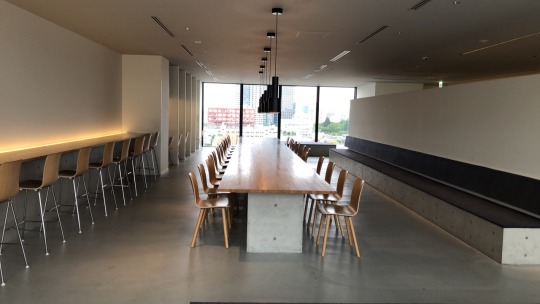
Capsule hotels don't cost much for a solo traveler but just a heads up, it could get very expensive if you travel as a family, since everybody pays for each capsule. I feel like it should be a required experience when you visit Japan the first time, if you're willing to stay at least a day or two.
I know this blog falls under my Tokyo series, but it is also relevant in other bigger cities, such as Osaka, Nara, and Kyoto - so don't limit these culture shocks in the mega-city alone.
I am currently on the train from Kyoto to Tokyo on our way to depart for Incheon, since our summer study abroad program starts this week! I will try to finish all my Japanese blogs before orientation on Tuesday (I'm writing this on a Sunday).
Regarding my third Tokyo blog, I am still debating how to go about it. Should it be a personal or an informational account? I'm just fearful of how fast it would become questionable or controversial for a blog that is going to be read by prospective summer abroad students from my school.
I feel like it is necessary though - after all, I am writing these blogs for me to read and reminisce in the future, and my experiences with the gay red light districts in Tokyo and Osaka played a vital role on making my trip as memorable as it was. No need to worry though, I am definitely certain to spare the specifics. Until then!
さようなら、
Chris 「クリス」
P.S. I have the Korean placement exam on Wednesday, so I have three days to review my written and oral Korean skills since I don't want to be placed in a Korean class I've already taken just because I do not remember any basic vocabulary or grammar points. Wish me luck!
0 notes